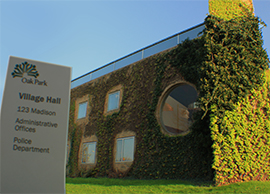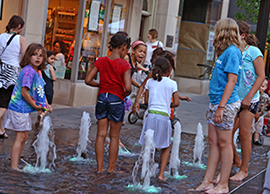May 16, 2016 – Oak Park forestry superintendent Rob Sproule has a straightforward way of describing his department’s role in the community.
“If it’s green in this town, we take care of it,” Sproule said.
To be specific, Sproule and his crew of five forestry employees oversee the nearly 19,000 trees growing on parkways throughout the village, not to mention the bushes, shrubs and flower planters that are also a part of public landscaped areas.
Beginning May 24, the forestry division is working with contractors to plant nearly 350 trees across the Village over the course of about a week. Thirty-six different kinds of trees will be planted as foresters focus on species diversity as a way to prevent the widespread loss that can occur when an urban forest lacks variety and becomes susceptible to outbreaks like Dutch elm disease and the emerald ash borer.
Planting specifics
About 75 of the new trees will be planted in the medians of the 900, 1000, 1100 and 1200 blocks of North Kenilworth Avenue, where 97 trees were removed in the past year because of declining condition and age. The majority of the trees removed in the North Kenilworth medians were ornamental hawthorn trees, and they are being replaced by a variety of shade trees and a mix of ornamental shrubs and birch trees.
In addition to its annual spring tree planting, the Village also schedules a fall planting in November when another 200 or so trees likely will be planted.
The majority of annual plantings replace trees infected with Dutch elm disease and the emerald ash borer, but Sproule said he and his staff are seeing an increase in Norway maple and linden trees that have reached the end of their life spans and require removal.
When a tree is removed, the location is entered in the Village’s inventory of trees in the public way and a new tree is typically replanted within two seasons.
Sproule manages when, where and what trees will be planted. While requests for specific species will be considered, the Village cannot provide a list of available tree species from which a resident can select since site conditions and species availability vary greatly from season to season.
“People really want to be involved in the decision of what tree grows in front of their house, and that’s really difficult to manage when you’re talking about hundreds of trees in a contract,” Sproule said.
Smaller trees, greater success
When the Village plants new trees, they are typically 10 to 15 feet tall with a two-inch trunk diameter and a 36-inch root ball. Each new tree is planted and mulched, and a watering bag is attached and refilled regularly during the first growing season. Residents are urged to store the watering bags and use them in future years to help the trees on the parkways stay strong during their most vulnerable years.
Experience has shown that smaller trees transplant best in Oak Park’s urban environment, and that the additional costs of transplanting larger trees do not translate into any long term benefits.
“The cost goes up exponentially when transplanting larger trees. The chance of failure also goes up exponentially with larger trees. The cost and risk are hard to justify when you consider that if you plant a two-inch tree and a four-inch tree at the same time, within five years they’re going to look the same,” Sproule said.
Fostering species diversity
In 2015 Oak Park was recognized as the state’s first municipal arboretum, and the Village maintains an active and regularly updated inventory of trees in the public way. Residents may use the online inventory to identify trees on their parkways and throughout the Village.
At the time of the last comprehensive inventory in 2014, maple trees made up 24 percent of the tree population in Oak Park, followed by elm trees (11 percent), linden trees (10 percent) and oak trees (nine percent).
Sproule says the goal for a healthy urban forest is to not have any species family make up more than 10 percent of the overall population. With this objective in mind, large quantities of oak, tulip, buckeye and pear trees are being planted this spring while maple trees make up only a small fraction of the new arrivals.
“Oak Park is known for being pretty progressive in its tree maintenance and care,” Sproule said. “We take a lot of pride in making sure we have a high-quality, diverse urban forest.”
For more information on tree care in the Village visit www.oak-park.us/trees.










